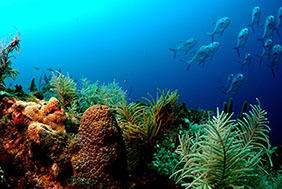-
Home
-
Data & Publications
-
Regional Portals
- About Regional Portals
- Florida
- Navassa Island
- Puerto Rico
- Flower Garden Banks
- U.S. Virgin Islands
- American Samoa
- Commonwealth of the Northern Mariana Islands
- Federated States of Micronesia
- Guam
- Main Hawaiian Islands
- Republic of the Marshall Islands
- Northwestern Hawaiian Islands
- Republic of Palau
- Pacific Remote Island Areas
-
CRCP Activities
- Glossary
Coral Bleaching Futures - Downscaled projections of bleaching conditions for the world's coral reefs, implications of climate policy and management responses

Increasingly frequent severe coral bleaching is among the greatest threats to coral reefs posed by climate change. Global climate models (GCMs) project great spatial variation in the timing of annual severe bleaching (ASB) conditions; a point at which reefs are certain to change and recovery will be limited. Previous model-resolution projections (approximately 1x1°) are too coarse to inform reef management planning (recognized, for example, in SAMOA Pathways, paragraph 44b). To meet the need for higher-resolution projections, this report presents statistically downscaled projections (4-km resolution) of the timing of ASB for all the world's coral reefs using the newest generation of IPCC climate models (CMIP5). Results are reported by country and territory, grouped in bioregions based on the 10 UNEP Regional Seas programmes with coral reefs (also including countries or territories in or near the Regional Sea area but not participating in the Regional Sea).
Among the goals of the Paris Agreement adopted at the UNFCCC Conference of Parties (COP) in 2015 is to hold temperature "well below" 2°C while also pursuing efforts to stay below 1.5°C. This legally binding agreement entered into force 4 November 2016. This report evaluates the implications of the Paris Agreement for coral reef futures. Projections of ASB timing are compared between business as usual scenario (RCP8.5) and RCP4.5, which could represent emissions concentrations mid-century. This report makes the projections data and main findings publicly accessible to inform management and policy planning as well as to support education and outreach.
Citation:
Coral Bleaching Futures - Downscaled projections of bleaching conditions for the world's coral reefs, implications of climate policy and management responses. United Nations Environment Programme, Nairobi, Kenya. ISBN: 978-92-807-3649-6
Acknowledgements:
Financial and in-kind support for this research was provided by: UN Environment Program, NOAA Coral Reef Conservation Program, NOAA Atlantic Oceanographic and Meteorological Laboratory, NOAA National Marine Fisheries Service via the PIFSC, World Wildlife Fund, the US National Fish and Wildlife Foundation, USGS via the Pacific Islands Climate Science Center, the Pacific Islands Climate Change Cooperative, RSMAS at the University of Miami, and the European Research Council.
Coral Bleaching Futures - Downscaled projections of bleaching conditions for the world's coral reefs, implications of climate policy and management responses: (full report, pdf 2.83 MB)
For more information, contact:


